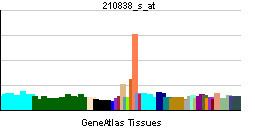Entrez 94 | Ensembl ENSG00000139567 | |
 | ||
Aliases ACVRL1, ACVRLK1, ALK-1, ALK1, HHT, HHT2, ORW2, SKR3, TSR-I, activin A receptor like type 1 External IDs OMIM: 601284 MGI: 1338946 HomoloGene: 20058 GeneCards: ACVRL1 | ||
Serine/threonine-protein kinase receptor R3 is an enzyme that in humans is encoded by the ACVRL1 gene.
Contents
ACVRL1 is a receptor in the TGF beta signaling pathway. It is also known as activin receptor-like kinase 1, or ALK1.
Function
This gene encodes a type I cell-surface receptor for the TGF-beta superfamily of ligands. It shares with other type I receptors a high degree of similarity in serine-threonine kinase subdomains, a glycine- and serine-rich region (called the GS domain) preceding the kinase domain, and a short C-terminal tail. The encoded protein, sometimes termed ALK1, shares similar domain structures with other closely related ALK or activin receptor-like kinase proteins that form a subfamily of receptor serine/threonine kinases. Mutations in this gene are associated with hemorrhagic telangiectasia type 2, also known as Rendu-Osler-Weber syndrome 2.
Pathology
Germline mutations of ACVRL1 are associated with:
Somatic mosaicism in ACVRL1 are associated with severe pulmonary arterial hypertension.
ACVRL1 directly interacts with low-density lipoprotein (LDL), which implies that it might initiate the early phases of atherosclerosis.
As a drug target
Closely/family related kinases
(Not to be confused with anaplastic lymphoma kinase (ALK) )
ALK4 is ACVR1B, ALK7 is ACVR1C, and ALK5 is [part of] the TGF-β type I receptor.
